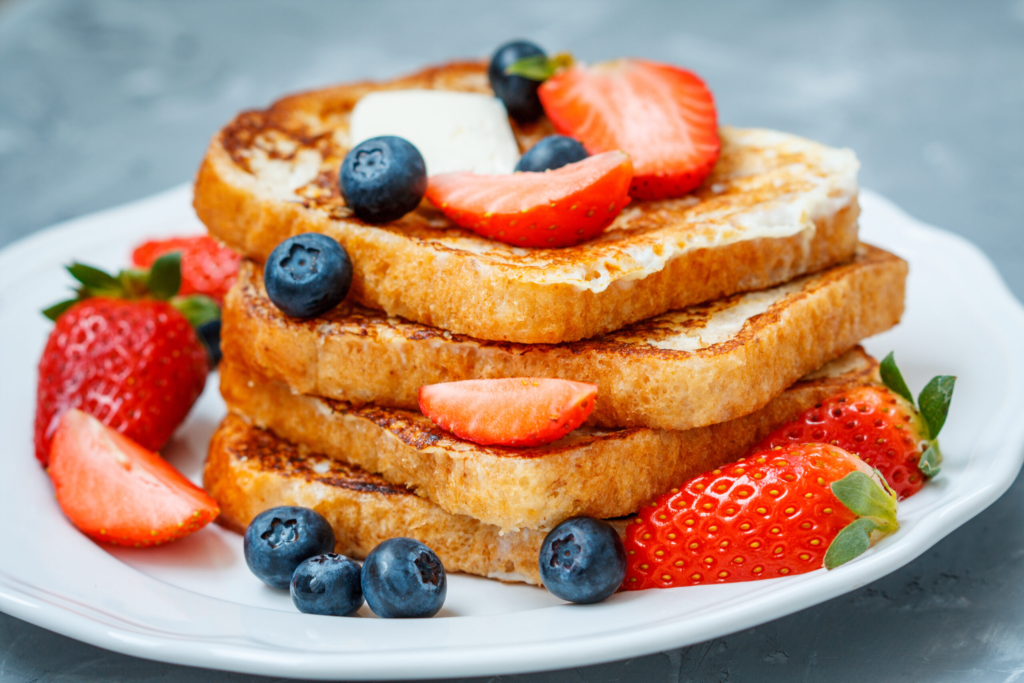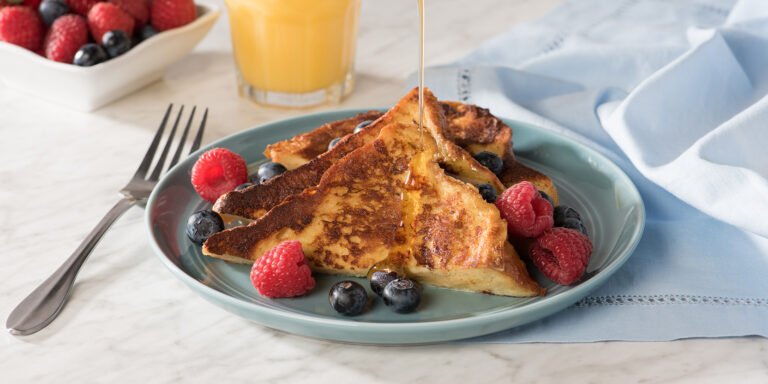Introduction to French Toast
French toast, a delightful dish made from slices of bread soaked in a mixture of eggs and milk before being fried, has a fascinating history that dates back centuries. Though often associated with French cuisine, the origins of this beloved breakfast can be traced to ancient civilizations, where bread was used in various ways to avoid waste. Over time, this culinary creation has evolved, adapted, and found its way into countless cultures worldwide, each adding its unique twist to the classic recipe.
In countries such as Spain, the dish is known as “torrija,” while in Germany, it is called “Arme Ritter.” Regardless of the name, the basic concept remains the same: a delicious and satisfying meal that transforms simple ingredients into something extraordinary. French toast is cherished not only for its rich flavor but also for its versatility; it can be sweet or savory, catering to a wide range of palates. Toppings such as syrup, fruit, whipped cream, or even eggs and bacon can turn a basic French toast recipe into a gourmet breakfast experience.
This blend of tradition and creativity contributes to the dish’s enduring popularity as a breakfast option. Its preparation is straightforward, making it accessible for cooks of all skill levels. Additionally, French toast can be easily tailored to suit individual preferences, allowing for adaptations in flavor, texture, and dietary needs. This article will focus on a simple French toast recipe for 1, perfect for those who enjoy the pleasure of cooking for themselves. With easy-to-follow steps, this recipe ensures that solo breakfast experiences and quick meals can be both delicious and satisfying.
Ingredients Needed for Your French Toast Recipe
Creating a delightful french toast recipe for 1 requires a selection of essential ingredients that contribute to the dish’s overall flavor and texture. The primary components are straightforward yet crucial. You will need two slices of bread, preferably a thick variety like brioche or challah, as these varieties absorb the egg mixture beautifully, resulting in a rich and satisfying outcome. Stale bread is often recommended, as it holds up better during cooking.
The next vital ingredient is the egg — one large egg is sufficient for this single serving. It serves as the binding agent, imparting richness and a smooth texture to the toast. Alongside the egg, you will require a splash of milk — about ¼ cup should suffice. This adds moisture and creaminess to the mixture. You may opt for dairy alternatives such as almond, coconut, or oat milk for a dairy-free version of the french toast recipe for 1.
Enhancing the flavor, a teaspoon of vanilla extract is essential. Additionally, for those who enjoy a hint of spice, incorporating a pinch of cinnamon into the egg mixture can elevate your dish further. Sugar may also be added to taste, although the sweetness often comes from optional toppings.
Speaking of toppings, the possibilities are expansive. Fresh fruit, maple syrup, whipped cream, or a dusting of powdered sugar can take your french toast to the next level. If you are looking for variations, consider using gluten-free bread for this recipe. With a few high-quality ingredients and minor adjustments, you can easily customize this breakfast favorite to suit your dietary preferences while enjoying a delightful meal in the morning.

Step-by-Step Instructions for Making French Toast
Creating a delicious french toast recipe for 1 is an enjoyable and simple process. Here is a step-by-step guide to help you achieve a perfect meal. Start by gathering your ingredients: one slice of bread, one egg, a splash of milk (around 2 tablespoons), a pinch of salt, and a sprinkle of cinnamon. Feel free to add vanilla extract for extra flavor. You will also need butter or oil for cooking.
Begin by breaking the egg into a bowl. Add the milk, salt, cinnamon, and vanilla extract if you’re using it. Whisk these ingredients together thoroughly until well-combined. This mixture is crucial for achieving that rich, flavorful taste that classic french toast is known for.
Next, prepare your bread. A thicker-sliced bread like brioche or challah works best, but feel free to use what you have on hand. Dip one side of the bread into the egg mixture, allowing it to soak for a few seconds. Make sure to coat both sides of the bread to fully absorb the flavors. If you prefer a crispier texture, lightly squeeze the bread to remove any excess liquid.
Now it’s time to heat your pan. Preheat a non-stick skillet or frying pan over medium heat and add butter or oil. The pan must be adequately heated to ensure even cooking. Once the butter has melted and starts to bubble, it’s time to add the soaked bread. Cook the toast for about 2-3 minutes on each side or until it turns golden brown. Check for doneness by gently lifting a corner of the toast; it should be firm yet slightly springy.
Avoid common mistakes such as overcrowding the pan; cook one slice at a time for the best results. Once cooked, transfer the toast to a plate and serve with your favorite toppings such as syrup, powdered sugar, or fresh fruit. This straightforward french toast recipe for 1 guarantees a delightful breakfast that is both satisfying and easy to prepare.
Serving Suggestions and Variations for Personalization
When preparing your delightful French toast recipe for 1, the opportunities for personalization are abundant. One of the simplest ways to elevate your dish is through toppings. Classic options such as maple syrup or honey provide a sweet complement to the custardy toast. For a refreshing twist, consider adding an assortment of fresh fruits. Slices of banana, strawberries, or blueberries can enhance both the flavor and presentation of your meal. A sprinkle of powdered sugar can also add a touch of elegance.
In addition to traditional sweet toppings, there are exciting savory variations to explore. Incorporating cheese into your French toast can yield a rich and satisfying dish. Try adding some gooey cheddar or creamy goat cheese while the toast is still warm, allowing it to melt slightly. For an herbaceous twist, sprinkle in some fresh herbs such as chives or parsley, which can add a subtle freshness to each bite.
If you wish to infuse different flavors directly into the French toast itself, consider mixing spices or extracts into the egg batter. A splash of vanilla extract or a dash of cinnamon can create an aromatic experience that complements your dish beautifully. Alternatively, adding a hint of orange or lemon zest can lend a bright, citrusy note that pairs wonderfully with the sweetness of the toast.
To complete your breakfast experience, think about the beverage options that accompany your French toast. A steaming cup of coffee or a soothing mug of herbal tea can provide a comforting balance. For a refreshing option, consider freshly squeezed orange juice or a vibrant smoothie. These beverages can enhance your meal and set the perfect tone for the day ahead.
You May Also Read:
